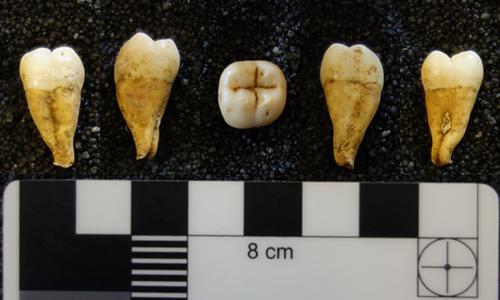当前位置:
X-MOL 学术
›
Am. J. Phys. Anthropol.
›
论文详情
Our official English website, www.x-mol.net, welcomes your feedback! (Note: you will need to create a separate account there.)
Desperately seeking stress: A pilot study of cortisol in archaeological tooth structures
American Journal of Physical Anthropology ( IF 2.8 ) Pub Date : 2020-10-07 , DOI: 10.1002/ajpa.24157 Leslie Quade 1 , Paul L. Chazot 2 , Rebecca Gowland 1
American Journal of Physical Anthropology ( IF 2.8 ) Pub Date : 2020-10-07 , DOI: 10.1002/ajpa.24157 Leslie Quade 1 , Paul L. Chazot 2 , Rebecca Gowland 1
Affiliation

|
Cortisol is a glucocorticoid hormone produced through activation of the hypothalamic pituitary adrenal axis. It is known as the “stress hormone” for its primary role in the body's stress response and has been the focus of much modern clinical research. Within archaeology, only a few studies have analyzed cortisol in human remains and these have been restricted to hair (Webb et al., 2010; Webb, White, van Uum, & Longstaffe, 2015a; Webb, White, van Uum, & Longstaffe, 2015b). This study examines the utility of dentine and enamel, which survive well archaeologically, as possible reservoirs for detectable levels of cortisol.
中文翻译:

拼命寻找压力:考古牙齿结构中皮质醇的初步研究
皮质醇是通过激活下丘脑垂体肾上腺轴产生的糖皮质激素。它因其在人体压力反应中的主要作用而被称为“压力激素”,并且已成为许多现代临床研究的重点。在考古学领域,只有很少的研究分析了人类遗体中的皮质醇,而这些皮质醇仅限于头发(Webb等,2010; Webb,White,van Uum和Longstaffe,2015a; Webb,White,van Uum和Longstaffe, 2015b)。这项研究研究了在考古学中幸存下来的牙本质和牙釉质的实用性,它们可能是可检测水平的皮质醇的储藏室。
更新日期:2020-10-07
中文翻译:

拼命寻找压力:考古牙齿结构中皮质醇的初步研究
皮质醇是通过激活下丘脑垂体肾上腺轴产生的糖皮质激素。它因其在人体压力反应中的主要作用而被称为“压力激素”,并且已成为许多现代临床研究的重点。在考古学领域,只有很少的研究分析了人类遗体中的皮质醇,而这些皮质醇仅限于头发(Webb等,2010; Webb,White,van Uum和Longstaffe,2015a; Webb,White,van Uum和Longstaffe, 2015b)。这项研究研究了在考古学中幸存下来的牙本质和牙釉质的实用性,它们可能是可检测水平的皮质醇的储藏室。



























 京公网安备 11010802027423号
京公网安备 11010802027423号